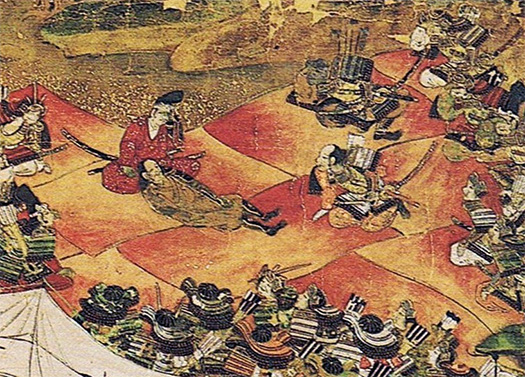

源平戦争研究篇に突入したブログであります(笑)。
本意ではないのですが、やはり屋島のことを書いていると源平合戦が
大きなテーマで浮かび上がってきてしまいますね。
少年時代「平家物語」を読んだ記憶があり母親に「源氏物語」を買ってくれと頼んだ。
買う寸前になって振り向いた母親が「本当に源氏物語読みたいのか?」と
念押しされて内容をかいつまんで説明されて驚いた記憶がある。
そうです、平家物語があるのだから反対の立場で源氏物語を想定していた・・・。
ということで、少年にはチンプンカンプンな王朝恋愛絵巻地獄は回避できた(笑)。
どうしても男子というのはこういう戦争ものには反応するのでしょう。
平家物語というのは琵琶法師というアナウンサーに楽器付きで
全国津々浦々の村の寺社の祭礼などで興行させる「メディア」でもあった。
たぶん日本社会で最初期のニュースメディア業態だったのだと思う。
題材として源平の軍記物ニュースは人々の強い興味関心を惹いたのでしょう。
このことが日本の情報流通の嚆矢となっていったと思います。
判官贔屓という日本人感覚はこういったメディアによって醸成されたとも思える。
上図は「屋島での継信最後(赤間神宮所蔵)」というWikipedia所載の画像の一部。
横たわっているのが義経に従っていた佐藤継信とのこと。
下写真はかれを埋葬する近隣の「州崎寺」。
かれは奥州藤原氏の家臣団武士で、義経が頼朝挙兵に参陣して以来、
主従の関係を持ってきていたとされている。
ただ、御恩と奉公という武士の観念からいえばかれの主は藤原秀衡であって、
義経はその主から軍事的に仕えることを命じられた存在に過ぎなかっただろう。
この屋島合戦で四国の内陸路から平家の屋島陣の背後を襲って、
驚いた平家軍が海上に逃避してから主戦が「矢合戦」になり、
その過程で「主」である義経を身を挺して守備し、矢で射貫かれて死んだとされる。
義経を平家方はねらったが源氏方も一騎当千の兵が主を防ごうと矢面に馳せた。
真っ先に進んだ継信は弓手の肩から馬手の脇へと射抜かれ落馬。臨終に当たり
〜「この世に思い置くことは」と尋ねる義経に「別に何もない。武士は敵の矢で
死は元より期するところ。源平合戦に奥州佐藤継信という者が讃岐国屋島の磯で、
主に代わり討たれたと末代まで語られることこそ今生の面目。」と死んだ。〜
平家物語琵琶法師としては泣かせる場面で、さぞ盛り上がったことでしょう。
この屋島の合戦では「矢」が主役だったようですね。
たぶん平家方は義経の弓術のコンプレックスを刺激して敵の戦意低下を狙って
扇子の挑発とか、義経の弓を分捕ろうと計画したけれどうまくいかなかった。
そしてたぶん義経の身を守ろうとした武士は奥州から付き従ったかれだけだったかも。
義経はこの屋島でも四国の現地武士の支援で陸路攻撃が可能になっている。
このことは鎌倉武士団と義経の葛藤を表しているのでしょうね。
English version⬇
[Death of Yoshitsune Sato Tsugunobu in the arrow battle Shikoku / Yajima-6]
This is a blog that has entered the Genpei War Research Edition (laughs).
I don’t mean it, but when I write about Yajima, the Genpei War
It comes to the fore with a big theme.
I remember reading “The Tale of the Heike” as a boy and asked his mother to buy “The Tale of the Heike”.
She turned around on the verge of buying and asked her mother, “Do you really want to read the Genji story?”
She remembers being surprised when she was reminded and explained the contents.
That’s right, because there is a Heike story, I was assuming the Genji story from the opposite standpoint …
So, for the boy, I was able to avoid the dynasty love picture scroll hell that was crazy (laughs).
By all means, boys will react to such warfare.
The Tale of the Heike is an announcer named Biwa Hoshi with an instrument.
It was also a “media” that was used for festivals at temples and shrines in villages all over the country.
I think it was probably the earliest news media format in Japanese society.
Genpei’s military news as a subject may have attracted a great deal of interest from people.
I think this became the beginning of information distribution in Japan.
It seems that the Japanese sense of Hoganbiiki was cultivated by such media.
The above figure is a part of the image on Wikipedia called “The Last Tsugunobu in Yajima (Akama Jingu Collection)”.
Lying is Sato Tsugunobu, who was following Yoshitsune.
The photo below is the nearby “Shusakiji” where he is buried.
He is a samurai of Oshu Fujiwara’s vassal corps, and since Yoshitsune joined Yoritomo’s troops.
He is said to have had a master-slave relationship.
However, from the samurai’s idea of gratitude and service, his lord is Hidehira Fujiwara.
Yoshitsune would have only been commanded by his Lord to serve militarily.
In this Battle of Yashima, attacking behind the Yashima camp of the Heike from the inland route of Shikoku,
After the surprised Heike army fled to the sea, the main battle became “Arrow Battle”,
In the process, it is said that Yoshitsune, who is the “lord”, was struck and defended, and was shot through by an arrow and died.
Heike aimed at the general Yoshitsune, but Genji also struck a chord with the soldiers of Ikki Tousen to prevent the Lord.
Tsugunobu, who went ahead, was shot from the shoulder of the archer to the side of the horseman and fell. At the end
~ Yoshitsune asks, “Do you have any thoughts on this world?” “Nothing else. The samurai is an enemy’s arrow.
It’s about to die. In the Genpei War, a person named Tsugunobu Sato of Oshu was on the rocky shore of Sanuki no Kuniyajima.
He died when he answered, “It is the face of this life, the memory of the soul, that it is said that he was defeated by the Lord until the last generation.” ~
The Tale of the Heike Biwa Hoshi would have been excited about the scene that made him cry.
It seems that the “arrow” was the main character in this battle of Yashima.
Perhaps the Heike clan stimulates Yoshitsune’s archery complex to reduce the enemy’s fighting spirit.
I planned to provoke a fan or capture Yoshitsune’s bow, but it didn’t work.
And maybe the only samurai who tried to protect Yoshitsune was the one who followed him from Oshu.
Yoshitsune is also able to make land attacks on this Yajima with the support of local samurai from Shikoku.
This probably represents the conflict between the Kamakura Bushidan and Yoshitsune.
Posted on 1月 26th, 2022 by 三木 奎吾
Filed under: こちら発行人です, 日本社会・文化研究, 歴史探訪







コメントを投稿
「※誹謗中傷や、悪意のある書き込み、営利目的などのコメントを防ぐために、投稿された全てのコメントは一時的に保留されますのでご了承ください。」
You must be logged in to post a comment.